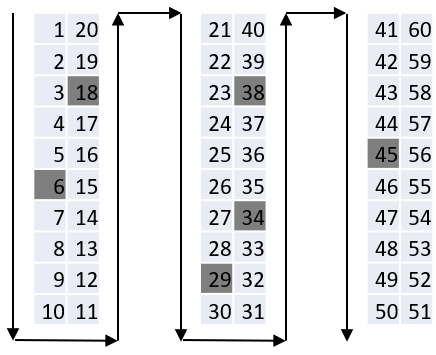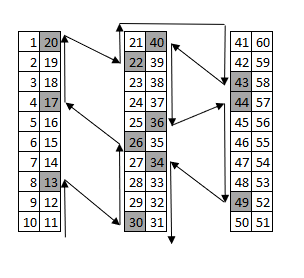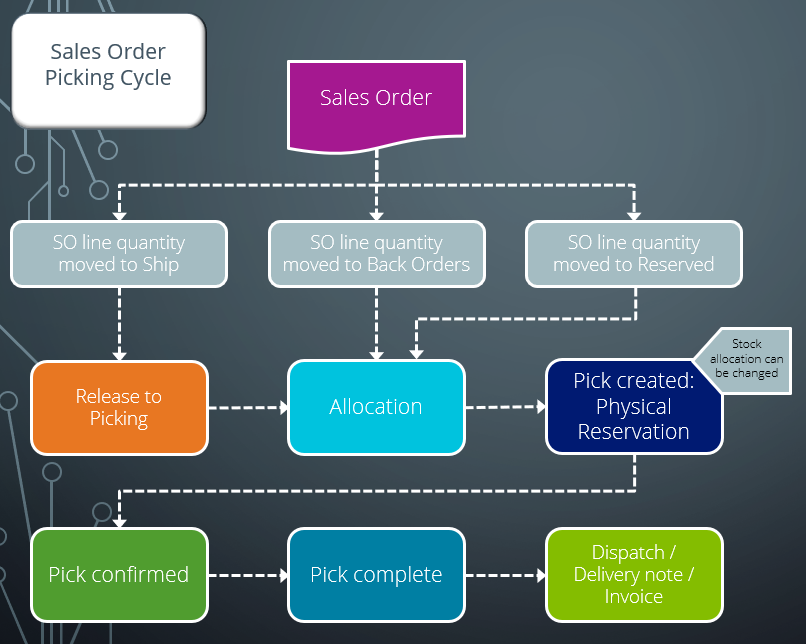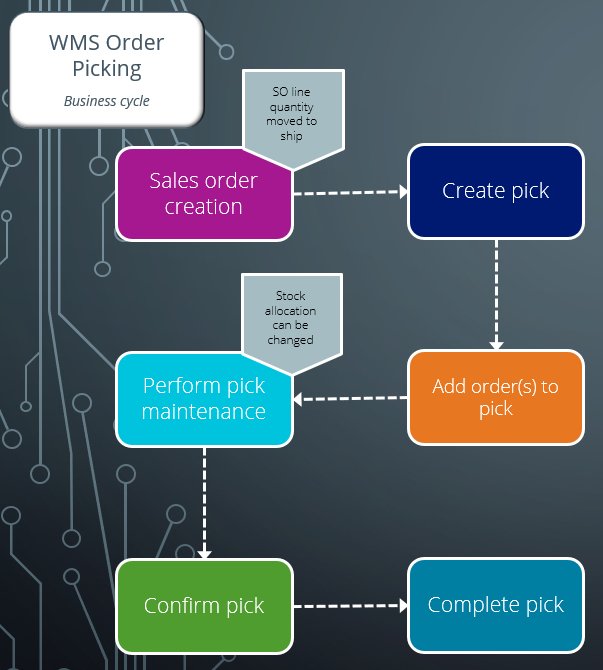Order Picking

The Order Picking feature provides picking routines to improve order book fulfillment and the management of the pick processes. It is an extension of the multi-bin functionality that is currently available in SYSPRO.
A mission can be generated from a sales order pick in order to assign picking tasks to the warehouse operation. The picking tasks can be completed using the Espresso Order Picking or Missions & Tasks application. The system is updated real time as the stock is picked and the task completed.
Exploring
A destination bin is configured as a dispatch bin (typically located in the dispatch area) and is required when you create a pick.
Once a pick is completed, a bin transfer is created (i.e. from the bin allocated against the stock code on the sales order to the destination bin entered).
This is the warehouse optionally configured to store variances arising during picking or cycle counting.
The quantity that is short is moved to the lost and found warehouse at the time the pick line or entire pick is completed and set to C - Picked.
Items can be retrieved from the L&F warehouse during cycle counting using the Lost and Found Warehouse Review program.
The lost and found warehouse is only enabled if a warehouse is defined at the Lost and found warehouse setup option and Process to lost and found warehouse is selected at the Accounting for shortages option (Warehouse Maintenance) .
This is the process of finding and extracting products from a warehouse bin to fulfill customer sales orders.
This is a bin transfer movement type that applies when you complete a pick. The quantity picked is transferred from the sales order bin to the destination bin.
For Order Picking, the destination bin of the generated pick can be selected within the SO Picking Options program.
This is a report that details the items required for picking and where to locate them.
A picking slip can only be printed once a pick has been created. Thereafter, you can print the pick slip at any time until it is complete.
A sales order may be set aside to create a pick at a later stage. These sales orders have not yet allocated stock.
You use the Pick Review program to select these sales orders (at a later stage) to create a pick.
Sales orders are used to record the sale or transfer of goods and services to both internal and external customers.
It forms a temporary legal contract between your company and the customer, as well a providing an audit trail of goods sold or transferred.
This denotes a scenario where the original quantity for a sales order cannot be satisfied with the actual quantity found in the bin, resulting in an outstanding quantity for the sales order line.
If you decide to complete this pick while there is outstanding quantity, the outstanding quantity is placed on back order.
Within SYSPRO, a warehouse represents an actual warehouse containing your inventory items (i.e. a physical warehouse) or a grouping of your inventory according to specific characteristics of the item (i.e. a logical warehouse).
For example:
You may want to split your inventory raw materials and finished goods into different logical warehouses even though they are located in the same physical warehouse.
You maintain warehouses using the Warehouse Maintenance program.
A mission can be created for inventory putaway, sales order pick or cycle count transactions. Once missions and tasks are assigned to the employee or team they can be serviced using the Missions & Tasks application in SYSPRO Espresso (where operators can then view their tasks from a mobile device) or the WHM Review Mission Tasks program using the SYSPRO Desktop or SYSPRO Web UI (Avanti).
The system is updated in real time as the stock is allocated, physically moved and the task completed. Once all tasks are done, the mission can be completed.
Starting
To use this feature, the following setup option(s) must be enabled/defined:
Setup Options > Configuration > Distribution > Inventory
- Multiple bins
- Associate serials by bin
- Fixed bins
- Show Warehouses (hyperlink)
- Picking cycle in use
- Accounting for shortages
- Process as stock adjustments
- Process to lost and found warehouse
- Lost and found warehouse
- Pick allocation override
-
- Enable for sales order picking
You can secure this feature by implementing a range of controls against the affected programs. Although not all these controls are applicable to each feature, they include the following:
- You restrict operator access to activities within a program using the Operator Maintenance program.
- You can restrict operator access to the fields within a program (configured using the Operator Maintenance program).
- You can restrict operator access to functions within a program using passwords (configured using the Password Definition program). When defined, the password must be entered before you can access the function.
- You can restrict access to the eSignature transactions within a program at operator, group, role or company level (configured using the Electronic Signature Configuration Setup program). Electronic Signatures provide security access, transaction logging and event triggering that gives you greater control over your system changes.
- You can restrict operator access to programs by assigning them to groups and applying access control against the group (configured using the Operator Groups program).
- You can restrict operator access to programs by assigning them to roles and applying access control against the role (configured using the Role Management program).
Solving
When canceling a pick detail line, the following occurs:
- The stock quantity allocated to the pick is released.
- The bin, lots and serials are detached.
-
The detail line is removed from the pick.
-
The original quantity to pick is placed into back order against the sales order line.
- You can add this sales order line to a new / existing pick or release it for picking when it is released from back order.
You can't maintain a pick that has been canceled.
Solution
You will have to create a new pick from within the Sales Order Entry program.
- Open the sales order using Sales Order Entry.
- Enter the ship quantity on the order lines.
- Select End Order.
- Re-enter the picking options.
-
Select Confirm to save the picking options.
The Bins, Lots & Serial Allocation program is displayed.
- Allocate the bins, lots and serials and select End Allocations.
- Create the pick using the Pick Review program.
Yes, you can save a pick during the picking process and resume the picking at a later stage.
- To save an incomplete pick, select Save Pick from the toolbar.
- Resume the picking by searching for and selecting the pick again at the Pick field.
Various things may take place:
- Even though there is a stock shortage, the pick status is still updated to C - Picked when the pick is closed.
-
When the Quantity picked is less than the Quantity to pick, a shortfall is automatically recorded against the Lost and found warehouse if you selected Process to lost and found warehouse at the Accounting for shortages setup option (Warehouse Maintenance). The shortfall is recorded when the pick or pick line is set to complete.
- The shortfall is included in back order and another pick can be generated in the picking process to manage this.
- If the shortfall is not processed to the lost and found warehouse, a transaction is generated to post the shortage to the ledger.
- The cycle count process may identify an excess of that stock code in another location, indicating that the stock was found, or it will be written off at year-end as lost.
You have to add the stock items to an existing pick or create a new pick from within the Back Order Release program.
Solution
- Review the back orders using the Back Order Release program.
- Select the back order you want to release on the SO Back Order Release pane.
-
Select Apply Release Qty from the context-sensitive menu or toolbar.
The SO Picking Options program is displayed.
- Enter the picking options.
-
Select Confirm to save the picking options.
The Bins, Lots & Serial Allocation program is displayed.
- Allocate the bins, lots and serials and select End Allocations.
- Create the pick using the Pick Review program.
A stock shortfall typically occurs when stock is missing from a warehouse, and can be captured as follows:
- Start picking using the Pick Maintenance program.
- In the Pick Detail Lineslistview, mark the line as picked by selecting the tick box in the Picked column.
-
Enter the actual quantity that was picked at the Quantity picked column and save the changes.
When the Quantity picked is less than the Quantity to pick, a shortfall is automatically recorded against the Lost and found warehouse if you selected Process to lost and found warehouse at the Accounting for shortages setup option (Warehouse Maintenance). The shortfall is recorded when the pick or pick line is set to complete.
The warehouse where the shortfall is recorded is displayed at the Lost and found bin field in the Pick Detail Lines listview.
Nothing is displayed in the Lost and found bin column if you selected Process as stock adjustment at the Accounting for shortages option.
You can override the bin, lot or serial that was allocated to the pick using the SYSPRO Desktop version as well as SYSPRO Espresso.
-
Launch the Pick Maintenance program.
-
At the Pick field, enter or select the pick for which you want to change the stock allocation.
The selected pick's details and pick lines are displayed.
-
Select the Edit hyperlink at the Override allocation column in the Pick Detail Lineslistview.
The Edit hyperlink is only available (i.e. you can only allocate different stock to the pick) if the status of the pick line is O - Outstanding and the Pick allocation override setup option is enabled against the warehouse.
You can select the status to change the status of the pick line.
The Sales Order Pick Allocation Override program is displayed.
-
Enter the bin, lot or serial and if required, the quantity.
-
Select the Add to list option.
-
Select Yes at the pop-up message that prompts you to confirm if you want to accept the allocations.
You can only save the allocation once you have allocated the same stock quantity that was allocated before.
You are returned to the Pick Maintenance program.
-
-
Exit the Pick Maintenance program.
Use the Pick Amendment Journal program to generate a report of all pick lines where the original stock allocation was overridden.
-
Launch the Missions & Tasks or the Order Picking application.
-
At the Pick field, enter or select the pick for which you want to change the stock allocation.
The selected pick's details and pick lines are displayed.
-
Edit the pick line for which you want to change the stock allocation.
-
Select the Override allocations option.
The Override allocations option is only available (i.e. you can only allocate different stock to the pick) if the status of the pick line is O - Outstanding and the Pick allocation override setup option is enabled against the warehouse.
Select the Change line status option to change the status of the pick line.
The Override Pick Allocations application is displayed.
-
Enter the bin, lot or serial and if required, the quantity.
-
Select the Add line option.
The allocation detail line is added to the grid. You can select the Edit option to edit the line.
-
Once you have allocated the same stock quantity, you can select the Save line option.
You are returned to the Missions & Tasks or Order Picking application.
-
Once a pick is completed, you can't change the order quantity or dispatch quantity or the quantity linked to the order or dispatch line. You also can't cancel the sales order or sales order line once the pick has been completed, nor change the quantity on the dispatch note.
If you need to reduce the quantity you want to dispatch after the pick has been completed, you have two options:
-
Either continue to invoice the customer for the picked quantity and then process a credit note, or
-
Invoice the dispatch note and then create a credit note.
Using
There are many roles that perform these tasks within the overall process, each driven by specific process stages.
| Process Stage | Role |
|---|---|
|
Order maintenance – Create pick |
|
|
Back Order Release (order fulfillment) –Create pick |
|
|
Add order release to existing pick |
|
|
Monitor pick work-to-list |
|
|
Perform / Record pick maintenance |
|
|
Override stock allocation |
|
|
Cancel pick |
|
|
Confirm pick (2nd stage) |
|
|
Complete pick |
|
The following indicates areas in the product that may be affected by implementing this feature:
Program List > Sales Orders > Picking
This program lets you maintain picks.
The stock allocation linked to the pick can be maintained by selecting the Edit hyperlink at the Override allocation column.
Program List > Inventory > Setup
The following fields have been added to the Warehouse Maintenance pane:
- WMS control section:
- Picking cycle in use
- Accounting for shortages
- Lost and found warehouse
- Pick allocation override
Program List > Inventory > Warehouse Management > Missions and Tasks > Setup
This program lets you allocate a team to a mission.
Program List > Inventory > Warehouse Management > Missions and Tasks > Setup
This program lets you add and maintain the employees that form part of the teams to which missions can be allocated.
Program List > Inventory > Warehouse Management > Missions and Tasks > Setup
This program lets you add and maintain the teams that can be allocated to missions.
SYSPRO Ribbon bar > Setup > Operators
The Employee field lets you link the SYSPRO operator to an employee who can be part of a team that can be allocated to a mission.
This link is required to filter the list of tasks according to the SYSPRO operator, which in turn limits the tasks the logged on Espresso operator can perform.
Program List > Sales Orders > Sales Order Processing
The following field description has changed in the Stocked Line pane:
- Ship quantity becomes Reserved quantity when using order picking.
The following program can be accessed when order picking is enabled:
- SO Picking Options (launched when ending the order with items from a picking enabled warehouse).
Program List > Sales Orders > Sales Order Processing
The following programs can be accessed when order picking is enabled:
- Pick Review (launched when allocating sales order lines to a pick).
- SO Picking Options (launched when ending the order with items from a picking enabled warehouse).
Accessible from various functions within the Sales Order Entry, Sales Order Entry Express, Back Order Release and Release Reserved Stock programs.
This program lets you reserve an order for picking, create a new pick or add to an existing pick.
The Create Mission and tasks option lets you create a mission from the sales order pick.
Accessible from the Edit hyperlink at the Override Allocation column within the Pick Maintenance, program.
This program lets you override the stock item that was originally allocated to the pick.
Program List > Inventory > Warehouse Management > Missions and Tasks
This program lets you delete completed and canceled missions (i.e. remove the mission data from the WhmMission and WhmMissionTasks database tables).
Program List > Sales Orders > Picking
This program lets you view sales order lines that have been released for picking, but not yet included in a pick.
Program List > Inventory > Cycle Counting System > Transaction Processing
This program lets you review stock items that were placed in the lost and found warehouse during the picking process or cycle counting.
Once investigated, stock items can be adjusted or transferred to the warehouse from which it came or to another warehouse.
Program List > Sales Orders > Sales Order Processing
The following Include/exclude option field has been added to the SO Reserved Stock Review Criteria pane:
- Lines in 'Picking' status only
Program List > Inventory > Warehouse Management > Missions and Tasks > Reports
This report displays the information for missions as well as the tasks allocated to these.
Program List > Sales Orders > Picking
This program lets you view pick header and detail lines.
Program List > Inventory
The following column has been added to the Warehouse Values listview:
- Allocated to picking
Program List > Sales Orders
The following fields have been added to the Sales Order Selection tab when selecting Preferences from the Options menu:
- Released for picking (R)
- In picking (P)
Program List > Inventory > Warehouse Management > Missions and Tasks
This program lets you query mission and task information. The tasks associated with the mission are displayed in the listview.
Program List > Inventory > Warehouse Management > Missions and Tasks
This program lets you allocate a mission to an employee as well as review missions and tasks.
Program List > Sales Orders > Picking > Browses
This program lets you view the details of picks.
Accessible when selecting the bin at the Warehouse Bins listview within the Browse on Warehouse Bins program.
This program displays the stock items that are stocked in a selected bin.
Accessible from the hyperlink at the Allocation column of the Pick Detail Lines listview within the Pick Maintenance, program.
This program lets you view the lots, bin or serial allocations recorded in the Sales Order Entry program.
Program List > Inventory > Browses
The following columns have been added to the listview:
- Lost and found warehouse
- Picking cycle
- Pick allocation override
Program List > Inventory > Warehouse Management > Browses
A link to the Stock Codes for Bin program has been added to the following field in the listview:
- Bin
Accessible from the Browse button at the Order field when maintaining a sales order using the Sales Order Entry program.
The following fields have been added to the Include preferences:
- In picking (P)
- Released for picking (R)
Program List > Inventory > Warehouse Management > Missions and Tasks > Browses
This program lets you browse the teams that can be allocated to missions.
Program List > Inventory > Warehouse Management > Missions and Tasks > Browses
This program lets you browse all missions and displays their statuses and sources (picking, cycle-counting or inventory putaway).
Program List > Inventory > Warehouse Management > Missions and Tasks > Browses
This program lets you view the employees that belong to a team.
The WHM Mission Team Maintenance business object lets you allocate a mission to a team.
The Teams Maintenance business object lets you add, change and delete teams that can be allocated to missions.
The WHM Mission Team Employee Maintenance business object lets you add, change or delete employees that form part of the teams to which missions can be allocated.
The SO Release Sales Orders to Picking business object lets you create a new pick on the sales order line as well as add the sales order line to the existing pick.
The SO Pick Status Change business object lets you change the status of a pick from S - Started to F - Confirming, X - Cancelled or C - Picked.
The business object also changes the status of pick lines.
The SO Pick Allocation Override business object lets you override a stock item's original bin, lot or serial that was allocated for picking. The updated allocation information is saved in the SorPickAmendJnl table.
The SO Pick Query business object lets you query sales order picks and display the pick lines for the entered pick number. Pick line details include the quantity in picking, the sales order line attached to the pick, and the status of each pick line.
The SO Pick Search Query business object lets you query picking detail lines.
The SO Pick Quantity Review business object displays a list of sales orders that have been reserved for picking, together with their corresponding ship quantities.
The SO Pick Amendment Journal Query business object lets you query all items that have been changed on a pick line using the data on the SorPickAmendJnl table.
The WHM Mission Query business object lets you query a mission, and the tasks associated with that mission, from the WhmMission table.
The WHM Missions Query business object lets you query missions in the WhmMissionTasks and WhmMission tables and displays their status and source (i.e. picking, cycle counting or inventory putaway). It is called from the WHM Review Mission Tasks program and loads the results in the listview.
The WHM In Progress Missions Query business object lets you query all missions from the WhmMission table that are still in progress (i.e. missions that are not canceled or completed).
Copyright © 2025 SYSPRO PTY Ltd.




